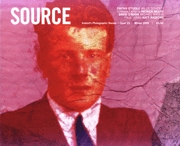Lost and Found
by Ciaran Carson
Issue 25 Winter 2000
View Contents ▸
View photographs collected by Patrick McCoy ▸
The 'of' in LOTS of LOVE seems an afterthought, its lower case squeezed in between the capitals. Below are a string of Xs and os. X stands for a kiss, O for a hug: there are nineteen kisses, and twenty, maybe twenty-and-a-half, hugs on the scrap of paper. Where it has been torn, just above the message, it has a soft, indefinite edge that suggests heavy paper, or card - photographic paper, perhaps. But what I am looking at is a photograph of a scrap of paper, and it is difficult to tell.
lsolated, the letters - the symbols - resonate. They march across the paper with the gravity of Egyptian hieroglyphs. O is life; it also stands for zero. Yet it is round and all-embracing; hence the hug. lt is used to formally address a person. lt can be used to express surprise or strong emotion: O say can you see, for example. By itself, it can be an exclamation of pleasure, or of pain: O! Some authorities derive it from the Semitic letter ayin, the eye. lt has an all-seeing generality, like the lens of the camera, and I am reminded of Roland Barthes' definition of the effect of the average photograph, in his Camera Lucida: lmage: Patrick McCoy, from 'Album'
lmage: Patrick McCoy, from 'Album'
"What I feel about these photographs derives from an average effect, almost from a certain training. I did not know a French word which might account for this kind of human interest, but I believe this word exists in Latin: it is studium, which doesn't mean or at least not immediately, "study", but application to a thing, taste for someone, a kind of general, enthusiastic commitment, of course, but without special acuity. lt is by studium that l am interested in so many photographs, whether I receive them as political testimony or enjoy them as good historical scenes: for it is culturally (this connotation is present in studium) that I participate in the figures, the faces, the gestures, the settings, the actions."
As for X, of all the letters in the alphabet, this is one of the most potent. lt is the Sign of the Cross, of Divine sacrifice. lt is the mark which represents the signature of an illiterate. lt denotes an unknown or unnamed factor, thing, or person. X marks the spot on a treasure map. lt is an act of cancellation. lt is a kiss: not a particularly lingering kiss, I imagine, but a swift peck, an audible gesture; a symbolic kiss. lt is swiftly written, sometimes written with such force that the pen makes a point at the end of a cross-stroke. lt is, literally, a punctuation, and now I am reminded more forcibly of Barthes' words, this time describing the emotion he feels when confronted by certain photographs, by certain gestures in these photographs, which move him beyond mere studium:
"l wanted to explore it not as a question (a theme) but as a wound... A Latin word exists to designate this wound, this prick, this mark made by a pointed instrument: the word suits me better in that it also refers to a notion of punctuation, and because the photographs I am speaking of are in effect punctuated, sometimes even speckled with these sensitive points; precisely, these marks, these wounds are so many points. This second element... I shall therefore call punctum; for punctum is also: sting, speck, cut, little hole - and also a cast of dice. A photograph's punctum is that accident which pricks me (but also bruises me, is poignant to me)."
The photographs reproduced here belong to that great generality of family snaps: they are commemorative devices, portraying weddings, babies, First communions, holidays. They are icons, showing the faces of the beloved. Looking at those which have been mutilated, we are shocked, as if a holy picture had been desecrated. Barthes' 'specks' and 'little holes' are not meant literally: here, they leap into our consciousness like 'Belfast confetti', that legendary ammunition of broken bricks, or shipyard nuts and bolts. Or it looks like some of the photographs have been used as a dartboard, slashed with a knife, splattered with blood. They are punctuated as if by machine-gun fire. Who could do such things? who would throw their treasured photographs away, to be discovered in this fashion?
Because discovered, they are lifted out of the realm of the banal, and we perceive again what photography means: that at one precise moment one day the light of the sun illuminated the features of this particular person or thing in such and such a way, which essential light was recorded forever by a mysterious archemy. We believe again that the camera captures our souls.
Hence the poignancy of these images. These are lost souls. Who are these half-obliterated figures? Are these people long dead, if dead at all? Why were they cast aside? Who inscribed, with barery literate devotion, these Xs and os? To whom were they addressed?
Asking these questions, we begin to question ourselves. Looking at these photographs, we feel guilty. Their subjects are too exposed, too like victims of purposeful assault, or of blind catastrophe. Yet we are drawn to look again and again, because our own eventual fate is mirrored in them. Photography, after all, is a form of death, since what was photographed is gone forever.
Other articles by Ciaran Carson:
Other articles mentioning Patrick McCoy:






